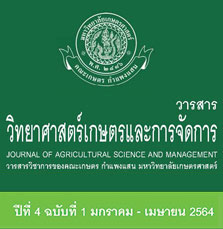ความหลากหลายทางพันธุกรรมของแตงกวาพันธุ์พื้นเมืองที่มีกลิ่นหอมเหมือนใบเตย ที่ประเมินด้วยเครื่องหมายเอสเอสอาร์
คำสำคัญ:
แตงกวา, กลิ่นหอมเหมือนใบเตย, ความหลากหลายทางพันธุกรรม, เครื่องหมายดีเอ็นเอบทคัดย่อ
ประเทศไทยเป็นส่วนหนึ่งของบริเวณศูนย์กลางความหลากหลายทางพันธุกรรมของแตงกวา เมื่อไม่นานมานี้มีการค้นพบแตงกวาพันธุ์พื้นเมืองของไทยที่มีกลิ่นหอมเหมือนใบเตย กลิ่นหอมเหมือนใบเตยเป็นลักษณะพิเศษที่เพิ่มมูลค่าในผลผลิตพืช เชื้อพันธุกรรมแตงกวากลิ่นหอมเหมือนใบเตยจึงมีความสำคัญและน่าสนใจในการใช้เป็นเชื้อพันธุกรรมในการพัฒนาแตงกวาพันธุ์การค้าให้มีกลิ่นหอมได้ อย่างไรก็ตาม ในปัจจุบันยังไม่มีความรู้ความเข้าใจเกี่ยวกับความหลากหลายทางพันธุกรรมและกำเนิดของพันธุ์แตงกวาที่มีกลิ่นหอมเหมือนใบเตย การศึกษานี้จึงมีวัตถุประสงค์เพื่อประเมินความหลากหลายทางพันธุกรรมของพันธุ์แตงกวาที่มีกลิ่นหอมเหมือนใบเตยที่พบในประเทศไทย เปรียบเทียบกับพันธุ์แตงกวาที่ไม่มีกลิ่นหอม ดำเนินการโดยวิเคราะห์ความหลากหลายทางพันธุกรรมของแตงกวาทั้งสิ้นจำนวน 96 พันธุ์ (พันธุ์ที่มีกลิ่นหอมจำนวน 7 พันธุ์ และพันธุ์ที่ไม่มีกลิ่นหอมจำนวน 89 พันธุ์) โดยใช้เครื่องหมายดีเอ็นเอเอสเอสอาร์ (simple sequence repeat (SSR)) จำนวน 10 เครื่องหมาย ที่กระจายตัวอยู่บน 7 โครโมโซมของแตงกวา ผลการทดลองพบว่า เครื่องหมายทั้งหมดตรวจพบอัลลีลทั้งสิ้นจำนวน 36 อัลลีล มีจำนวนอัลลีลต่อเครื่องหมายระหว่าง 2 (เครื่องหมาย SSR02895) ถึง 6 (เครื่องหมาย CS-SSR3) เฉลี่ยเท่ากับ 3.6 ค่า allelic richness ของแตงกวาพันธุ์ที่มีกลิ่นหอมกับพันธุ์ที่ไม่มีกลิ่นหอมมีค่าใกล้เคียงกัน โดยมีค่าเท่ากับ 23.43 และ 27.78 ตามลำดับ ความหลากหลายของยีน (gene diversity) ของแตงกวาทั้ง 96 พันธุ์ อยู่ในระดับปานกลาง โดยมีค่าเท่ากับ 0.52 และเมื่อเปรียบเทียบระหว่างแตงกวาพันธุ์ที่มีกลิ่นหอมกับพันธุ์ที่ไม่มีกลิ่นหอม พบว่า มีค่าไม่ต่างกันมาก โดยมีค่าเท่ากับ 0.37 และ 0.52 ตามลำดับ การจัดกลุ่มพันธุ์แตงกวาด้วยวิธี Neighbor-joining analysis, principal component analysis และ STRUCTURE analysis ให้ผลสอดคล้องกัน คือ พันธุ์แตงกวาที่มีกลิ่นหอมมีความแตกต่างทางพันธุกรรม และสามารถแบ่งออกเป็น 2 กลุ่มย่อย โดยแต่ละกลุ่มปะปนอยู่กับพันธุ์แตงกวาที่ไม่มีกลิ่นหอม ผลการศึกษานี้ แสดงให้เห็นว่า พันธุ์แตงกวาที่มีกลิ่นหอมมีความหลากหลายทางพันธุกรรมในระดับปานกลางและไม่แตกต่างจากพันธุ์แตงกวาทั่วไป และพันธุ์แตงกวาที่มีกลิ่นหอมอาจกำเนิดขึ้นในบริเวณที่ต่างกัน ความรู้และความเข้าใจเกี่ยวกับความหลากหลายทางพันธุกรรมและโครงสร้างประชากรของแตงกวาพันธุ์ที่มีกลิ่นหอมที่ได้จากการศึกษานี้สามาถนำไปใช้ในการอนุรักษ์และใช้ประโยชน์ในการปรับปรุงพันธุ์แตงกวาได้
เอกสารอ้างอิง
Anderson, J.A., G.A. Churchill, J.E. Autrique, S.D. Tanksley and M.E. Sorrells. 1993. Optimizing parental
selection for genetic linkage maps. Genome 36: 181-186.
Benbouza, H., J.M. Jacquemin, J.P. Baudoin and G. Mergeai. 2006. Optimization of a reliable, fast, cheap and sensitive silver staining method to detect SSR marker in polyacrylamide gels. Biotechnology, Agronomy, Society and Environment 10: 77-81.
Buttery, R.G., L.C. Ling, B.Juliano and J.G. Turnbaugh. 1983. Cooked rice aroma and 2-acetyl-1-pyrroline.
Journal of Agricultural and Food Chemistry 31: 823-826.
Chakraborty, R. and L. Jin. 1993. Determination of relatedness between individuals by DNA fingerprinting.
Human Biology 65: 875-895.
de Wilde, W.J.J.O and B.E.E. Duyfjes. 2010. Cucumis sativus L. forma hardwickii (Royle) W.J. de Wilde &
Duyfjes and feralforma sativus. Thai Forestry Bulletin (Botany) 38: 98-107.
Evanno, G., S. Regnaut and J. Goudet. 2005. Detecting the number of clusters of individuals using the
software STRUCTURE: a simulation study. Molecular Ecology 14: 2611-2620.
FAOSTAT. 2019. Cucumbers and gherkins. (Online). http://www.fao.org/faostat/en/#data/QC. (April 13, 2021).
Fushimi, T. and R. Masuda. 2001. 2-acetyl-1-pyrroline concentration of the aromatic vegetable soybean
Dadacha-mame. In Lumpkin, T.A., and S. Shanmugasundaram (Eds.). Proceedings of the 2nd International Vegetable Soybean Conference, Tacoma (39p.). Washington, USA: Washington State University.
Goudet, J. 1995. FSTAT (Version 1.2): a computer program to calculate F-statistics. Journal of Heredity 86:
-486.
Langella, O. 1999. Populations a free population genetic software. Version 1.2.28. (Online).
http://bioinformatics.org/~tryphon/ populations. (April 2, 2021).
Lodhi, M.A., G.N. Ye, N.F. Weeden and B.I. Reisch. 1994. A simple and efficient method for DNA extraction from
grapevine cultivars and Vitis species. Plant Molecular Biology Reporter 12: 6-13.
Luckanatinvong, V. and P. Sornkeaw. 2011. Quality of blanched aromatic young coconut fruits for export.
Agricultural Science Journal 42(1(Suppl.)): 147-150.
Lv, J., J. Qi, Q. Shi, D. Shen, S. Zhang, G. Shao, H. Li, Z. Sun, Y. Weng, Y. Shang, X. Gu, X. Li, X. Zhu, J.
Zhang, R. van Treuren, W. van Dooijeweert, Z. Zhang and S. Huang. 2012. Genetic diversity and
population structure of cucumber (Cucumis sativus L.). PLos ONE 7: e46919.
Pramnoi, P., P. Somta, S. Chankaew, R. Juwattanasomran and P. Srinives. 2013. A single recessive gene
controls fragrance in cucumber (Cucumis sativus L.). Journal of Genetics 92: 147-149.
Pritchard, J.K., X. Wen and D. Falush. 2007. Documentation for STRUCTURE software: Version 2.2. (Online).
http://pritch.bsd.uchicago.edu/software/structure22/readme.pdf. (April 28, 2020).
Ren, Y., Z. Zhang, J. Liu, J.E. Staub, Y. Han, Z. Cheng, X. Li, J. Lu, H. Miao, H. Kang, B. Xie, X. Gu, X. Wang,
Y. Du, W. Jin and S. Huang. 2009. An integrated genetic and cytogenetic map of the cucumber genome. PLoS ONE 4:e5795.
Ruangnam, S., S. Wanchana, N. Phoka, C. Saeansuk, S. Mahatheeranont, S.J. de Hoop, T. Toojinda, A.
Vanavichit and S. Arikit. 2017. A deletion of the gene encoding amino aldehyde dehydrogenase
enhances the pandan-like aroma of winter melon (Benincasa hispida) and is a functional marker for
the development of the aroma. Theoretical and Applied Genetics 130: 2557-2565.
Tamura, K., G. Stecher, D. Peterson, A. Filipski and S. Kumar. 2013. MEGA6: Molecular evolutionary genetics
analysis version 6.0. Molecular Biology and Evolution 30: 2725-2729.
Watcharawongpaiboon, N., and J. Chunwongse. 2008. Development and characterization of microsatellite
markers from an enriched genomic library of cucumber (Cucumis sativus). Plant Breeding 127: 74-81.
Weir, B.S. 1996. Genetic data analysis II: Methods for discrete population genetic data, Sinauer Associates
Sunderland, Massachusetts, p. 445.
Yundaeng, C., P. Somta, S. Tangphatsornruang, S. Wongpornchai and P. Srinives. 2013. Gene discovery
and functional marker development for fragrance in sorghum (Sorghum bicolor (L.) Moench). Theoretical and Applied Genetics 126: 2897-2906.
Yundaeng, C., P. Somta, S. Tangphatsornruang, S. Chankaew and P. Srinives. 2015. A single base substitution in
BADH/AMADH is responsible for fragrance in cucumber (Cucumis sativus L.), and development of
SNAP markers for the fragrance. Theoretical and Applied Genetics 128:1881-1892.






